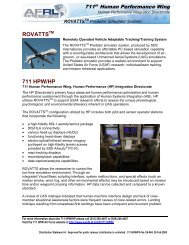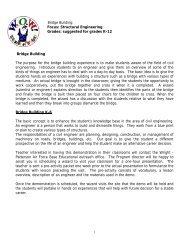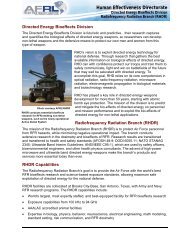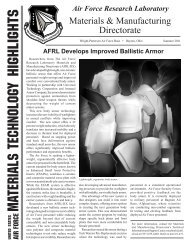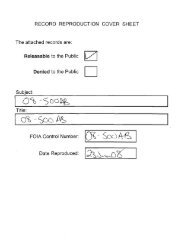AFMETCAL Newsletter - Wright-Patterson Air Force Base
AFMETCAL Newsletter - Wright-Patterson Air Force Base
AFMETCAL Newsletter - Wright-Patterson Air Force Base
Create successful ePaper yourself
Turn your PDF publications into a flip-book with our unique Google optimized e-Paper software.
Page 8<strong>AFMETCAL</strong> NEWSLETTERApril 2011Volume 31, Issue No. 3News and Notes (continued)(Continued from page 7)AFPSL TO Department (continued)while automated calibrations are being performed, etc.; but as a general rule, the test equipment calibration iscompleted before moving to the next type or piece. To illustrate the point, as a K1, K2, K8, and K9 writer, Icurrently have 3 of the 7 New TOs, the 1 Rewrite TO, and 12 of the 32 Revision TOs in work at the time ofthis writing. The dates due to <strong>AFMETCAL</strong> for these TOs range from March 4, 2011 to May 9, 2011. Myprimary focus is directed towards the Revision TO due first, but I also have to be aware of the TOs that follow.I must determine how much time is required to process all other TOs in a timely manner to allow the team leadand editors the time they require to perform their functions. The TO process clock never stops. Holidays,vacations, fire drills, etc., all take time away from the development process. With all of these TOs scheduledand in process, no matter how great our focus is on a TO, we can get a Rapid Action Change on a different TOfor which we have to stop and re-direct our attention and efforts to perform the change in the requiredmaximum of 10 calendar days. All writers consistently have significant workloads and the constant effort toensure all documents are being processed towards their completion requires a real balancing act. The constantinterruptions; phone calls, questions, E-mails, meetings, etc.; all break concentration, and we change our focusor have to recall exactly where we were in the process. (At my age, the recall thing is the greatest challenge.)To give you an idea of the scrutiny each TO undergoes, another area I would like to address is the inspectionprocess. Again, since I am writing this article, I will use myself as an example. I recently wrote a new TO fora Handheld Digital Multimeter Series, and it went through many changes in the process. Every word writtenwas inspected and evaluated by the team lead, technical editor, and format editor a number of times during thedevelopment process. It was turned in to <strong>AFMETCAL</strong> and evaluated by the TCM and the Technical OrdersQuality Assurance Personnel (TOQAPs). The TOQAPs also performed the grading of the procedure. After allthe inspections, it was determined that I had entered an incorrect specification range adder on theThermocouple Measurement section of the spreadsheet for one of the TIs. This caused two incorrect values inthe TO in the limits being tested. The TO was returned for correction. I use this point to illustrate theinspection process which continues even after we complete our own comprehensive internal reviews. FromJanuary 2009 through August 2010, the department completed over 1,500 TO packages, resulting in anastounding 98 percent pass rate for the time period. So to sum up the inspection process, all of the writers'work is inspected and evaluated by at least 5 people, they are graded on 100 percent of their workload and(Continued on page 9)Pictured at left (L to R):Robert Deaver, TO Department QA;Chris Jewell, Scott Hummel, AFPSL techniciansperforming a validation on a TO.




